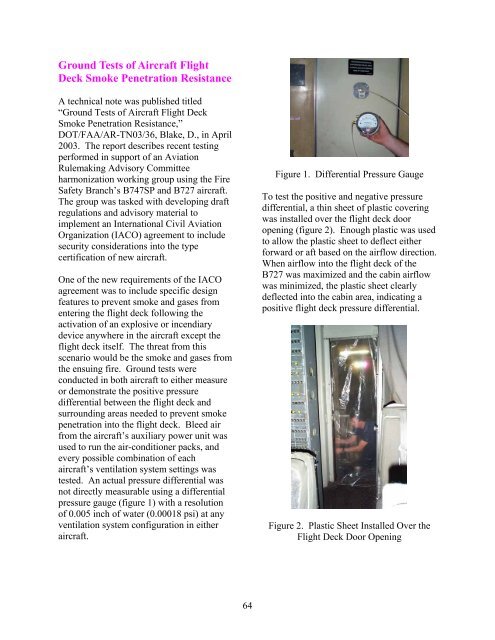AAR-400 Highlights 2002 - Fire Safety Branch - FAA
AAR-400 Highlights 2002 - Fire Safety Branch - FAA
AAR-400 Highlights 2002 - Fire Safety Branch - FAA
Create successful ePaper yourself
Turn your PDF publications into a flip-book with our unique Google optimized e-Paper software.
Ground Tests of Aircraft Flight<br />
Deck Smoke Penetration Resistance<br />
A technical note was published titled<br />
“Ground Tests of Aircraft Flight Deck<br />
Smoke Penetration Resistance,”<br />
DOT/<strong>FAA</strong>/AR-TN03/36, Blake, D., in April<br />
2003. The report describes recent testing<br />
performed in support of an Aviation<br />
Rulemaking Advisory Committee<br />
harmonization working group using the <strong>Fire</strong><br />
<strong>Safety</strong> <strong>Branch</strong>’s B747SP and B727 aircraft.<br />
The group was tasked with developing draft<br />
regulations and advisory material to<br />
implement an International Civil Aviation<br />
Organization (IACO) agreement to include<br />
security considerations into the type<br />
certification<br />
of new aircraft.<br />
One of the new requirements of the IACO<br />
agreement was to include specific design<br />
features to prevent smoke and gases from<br />
entering the flight deck following the<br />
activation of an explosive or incendiary<br />
device anywhere in the aircraft except the<br />
flight deck itself. The threat from this<br />
scenario would be the smoke and gases from<br />
the ensuing fire. Ground tests were<br />
conducted in both aircraft to either measure<br />
or demonstrate the positive pressure<br />
differential between the flight deck and<br />
surrounding areas needed to prevent smoke<br />
penetration<br />
into the flight deck. Bleed air<br />
from the aircraft’s auxiliary power unit was<br />
used to run the air-conditioner packs, and<br />
every<br />
possible combination of each<br />
aircraft’s ventilation system settings was<br />
tested. An actual pressure differential<br />
was<br />
not directly measurable using a differential<br />
pressure gauge (figure 1) with a resolution<br />
of 0.005 inch of water (0.00018 psi) at any<br />
ventilation system configuration in either<br />
aircraft.<br />
64<br />
Figure 1. Differential Pressure Gauge<br />
To test the positive and negative pressure<br />
differential, a thin sheet of plastic covering<br />
was installed over the flight deck door<br />
opening (figure 2). Enough plastic was used<br />
to allow the plastic sheet to deflect either<br />
forward or aft based on the airflow direction.<br />
When airflow into the flight deck of the<br />
B727 was maximized and the cabin airflow<br />
was minimized, the plastic sheet clearly<br />
deflected into the cabin area, indicating a<br />
positive flight deck pressure differential.<br />
Figure 2. Plastic Sheet Installed Over the<br />
Flight Deck Door Opening
















